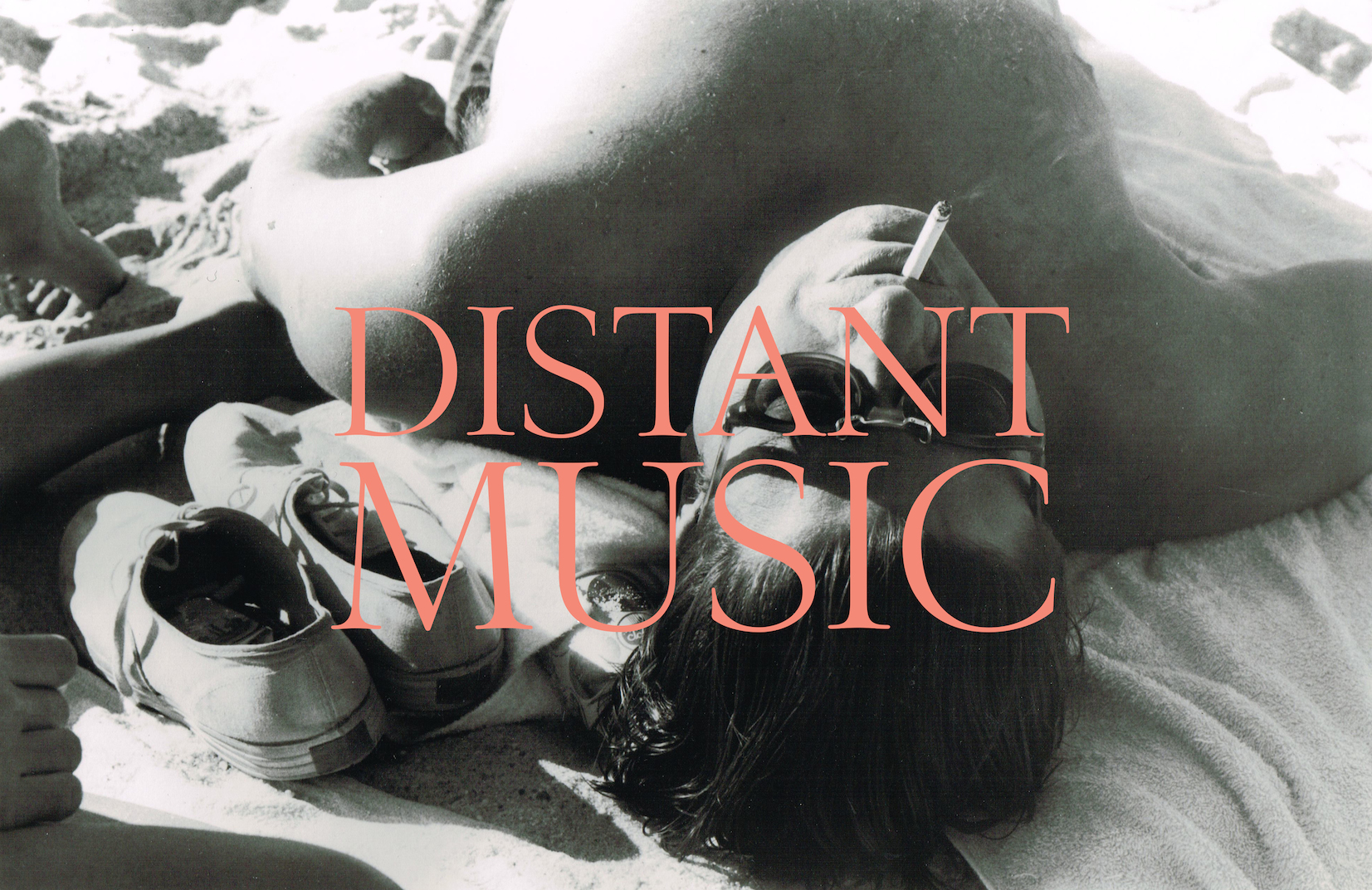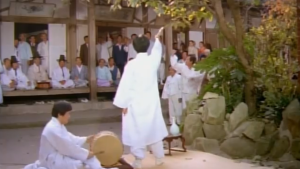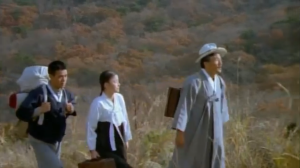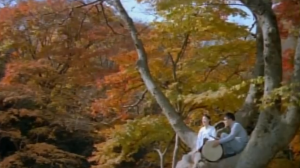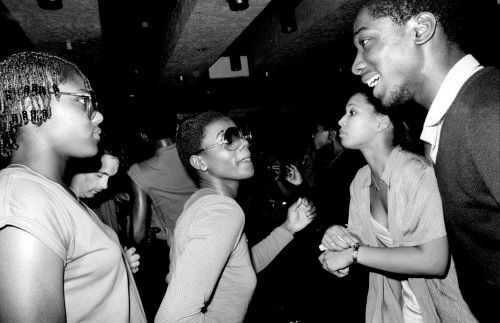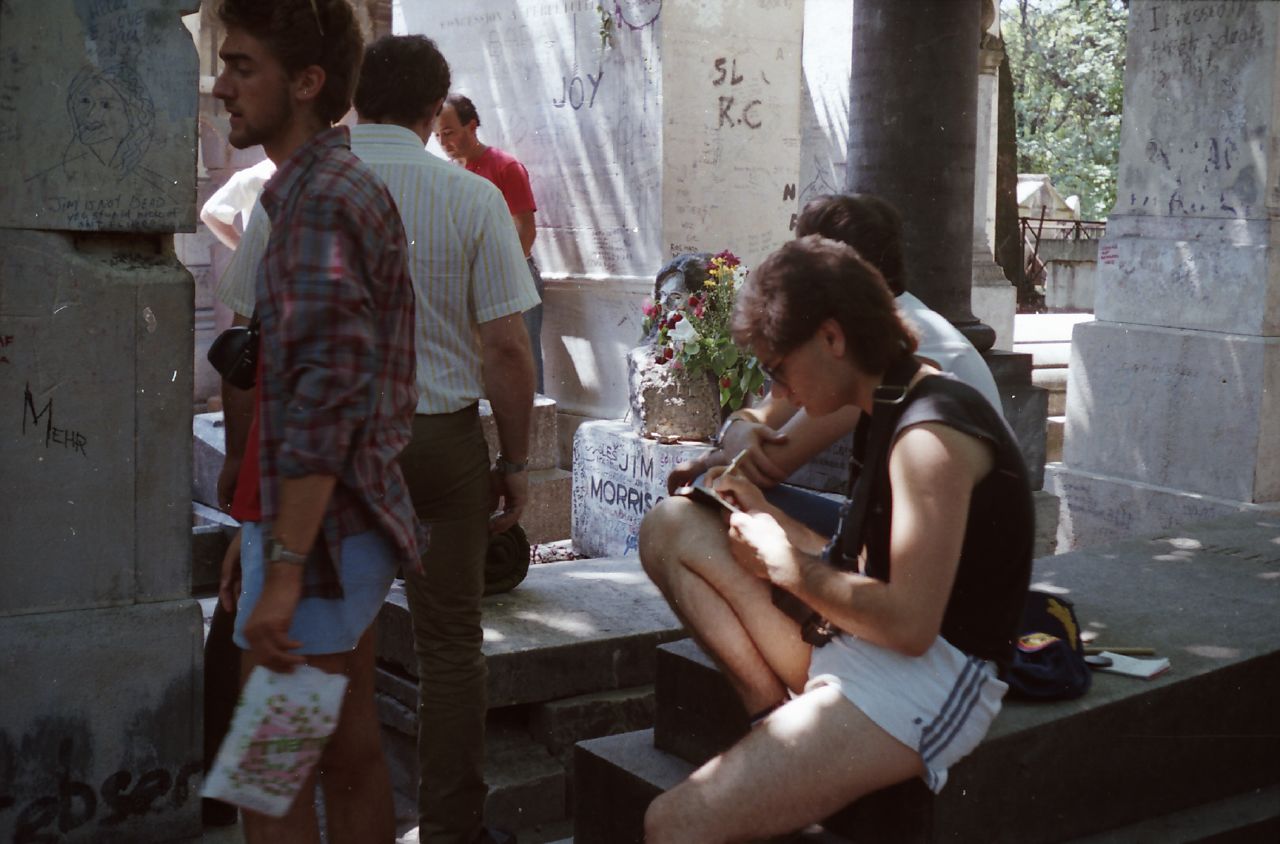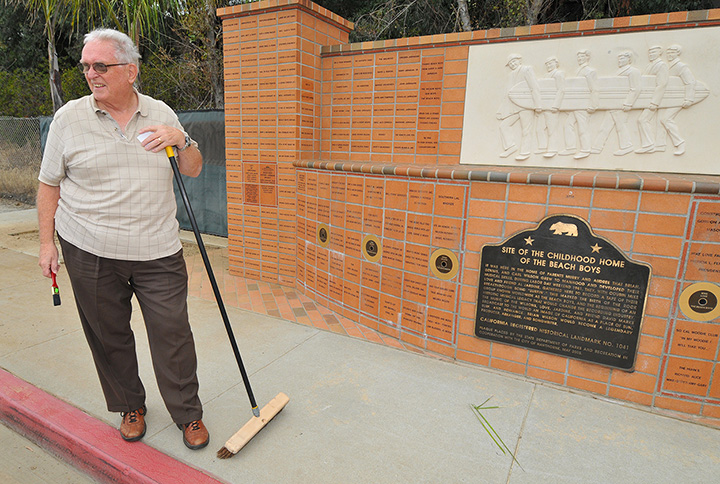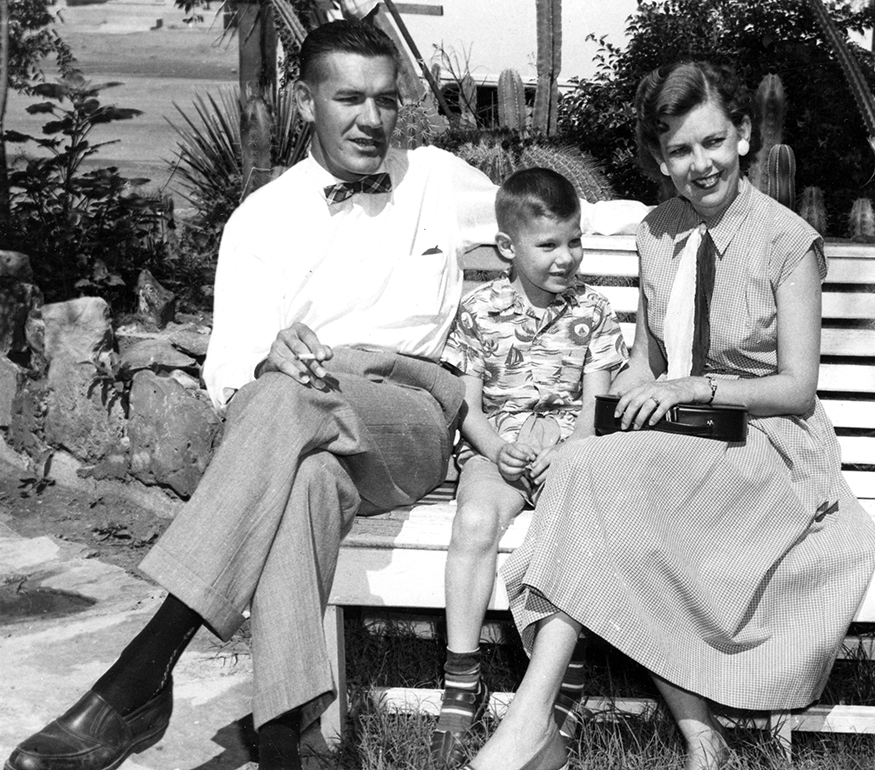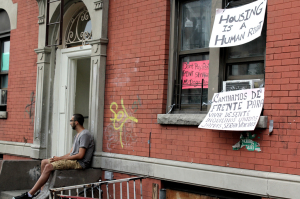Back to Issue
American Yeezus
by Sam Swasey
As is so often the case with new technologies, the impetus for the Internet can be found in warfare. In late 1960’s America, it was the Cold War that inspired the US Government’s research to develop a network of communication between computers. As the saying goes, “information is power,” and the party that informs most efficiently is most powerful.
While its origins are certain, today it would be inaccurate to conceive of a center point within the international web of communication that this earlier technology became. And although the researchers who developed this technology could not have fathomed what their invention would become, it nonetheless seems inevitable that the Internet would have its beginnings in America. Aside from the country’s wealth and the emphasis it puts on technological research, as well as the many developments made in other countries—developments this international web is contingent upon—it is as if the internet has an almost direct relationship with an ideological conception of freedom attributable to the American landscape.
Through the Great Plains of the Midwest we travel impeded only by our engines’ capabilities, speed limits, and the gas in the tank. Past weathered homes, American flags, and grand billboards of Jesus Christ that appear small in the vast landscape. On an impossibly flat road we drive, a fractal suspended in motion, within an immense network of interconnected roads and interstates. Past plots of houses of a very different kind—vacant, but fully furnished and adorned with manicured lawns—and on into the Rockies that rise abruptly from the Plains’ sleepy bed. We divide these peaks on roads that swerve and shake, rise and descend between crumbling heights.
As if held in an extended and controlled freefall we escape the mountains’ embrace, dropping into the desert below. Motels linger on its precipice, scatter and sometimes survive in its great interior. They offer their amenities to the night with colorful lights. These neon signs that boast “We Have Color TV” are reminiscent of, but perfectly unlike, those stuck to the café windows in our cities that exclaim “We Have Wi-Fi.” In both cases these declarations serve to verify our previous assumption. But whereas our expectations give that Wi-Fi sign an air of tackiness, it is this same privileged expectation that gives that “Color TV” a look of quaintness. Both sensations stem from the same: “ah, just as it should be.” Because in these motels there are always color TVs. They, like the neon signs that advertise them, the headlights of American cars, and the lights on buildings of American cities, seem always to be on. As with the saying we use if someone is inattentive or absentminded—“the lights are on but no-one’s home”—the air-conditioning cools these vacant rooms and the televisions light the walls and furniture with single-circuit information. Like the habitual, absentminded American smile, it makes no difference if anyone is home, so long as the visitor gets what he expects when he arrives. Infinite artifice—like a landscape behind a veneer of heat waves or the picture on an old TV set—America and its image quiver and lose themselves within each other.
Our bodies seem almost to disappear in the desert. Nearly devoid of any man-made objects or anything suggestive of the human mind, we, like sweat, begin to spread outward in infinite space. Perhaps one needs only to travel to the desert, or see it in an old Western, to understand why the harmonica imbedded itself so deeply in American music. Its dragging whine seems to fill us with the joy of suffering and, like the desert, reminds us of the loneliness of liberation.

Aerial View of Los Angeles
It is no wonder that Los Angeles, located near the desert’s edge, spreads out horizontally in every direction. At night, from a distance, the city’s lights seem to embarrass the sky. Its freeway system is nothing short of prolific—an immense network of on and off ramps and interweaving roads subdivided by a multiplicity of lanes. Thousands of humans in motion within an arms reach of one another, but dissuaded from contact by looming catastrophe. All of them are travelling between different locations with differing thoughts of where they were and where it is they are going. So while they sit side-by-side they are rarely in the same place at the same time. Trucks carry supplies to businesses and, if not already immersed in telephone discussions, these drivers carry messages of their day home to their loved ones. Did Los Angeles grow up to become the Internet? It might just be the best tangible example of a location that preceded our visual conception of the Internet’s architecture.

Map of the Internet
In 1954 American dance critic Edwin Denby wrote an essay he intended to deliver to the dance students at the Juilliard School. In it he noted that
Americans occupy a much larger space than their actual bodies do…This annoys many Europeans…But it has a beauty of its own, which a few of them appreciate. It has so to speak an intellectual appeal; it has because it refers to an imaginary space, an imaginary volume, not to a real and visible one.
Denby, who lived and wrote in New York, made these observations in a city composed of narrow streets and profound verticality, as opposed to horizontal and spacious L.A. Whether an American has ever travelled across the U.S. is perhaps irrelevant. No matter in what part of the country he lives, he is at least subconsciously aware of American space. It is imbedded in the national aesthetic, in its customs and daily life. From the certain way an American moves according to Denby, to our great love for all that is gigantic—from buildings, to engines, to Abstract Expressionist paintings, cheese burgers, and homes. It can be found in our music and the way we speak. American accents, albeit diverse, all drawl and spread words like some sort of paste of varying consistencies.
The sense of freedom that the American landscape inspires, and the one that shares a relationship with the liberation of mobility associated with the Internet, relates not to the filling of space with things grandiose and immense—this might be a purely American phenomenon—rather, it relates to our perception of ourselves within this space, and, space traversed. Unlike Europe, which has been divided by wars into bordered lands, the borders separating American states are connected vaguely by a united national ideology. Even when we consider the lingering disparity between North and South solidified during the American Civil War, these differences in opinions can hardly be conceived of as a geometric and timeless split on a map. Though a divide, not unlike one that existed in the 1860’s, can still be observed in the political leanings of, for instance, Massachusetts and Mississippi, this division gets hazier at the geographic point directly between these locations. In his essay “Up In Arms,” journalist and historian, Colin Woodard delves into the socio-historical past of various regions within America in order to conceive of a map which is a better representative of the country’s varying political beliefs. The country, in his opinion, is not exactly composed of 50 autonomous lands and cannot be divided easily into quadrants, but rather it is composed of 11 different “nations” all slightly amorphous, but held together by their respective political views. Between the far North, or “Yankeedom,” and the “Deep South” is an area he calls “Greater Appalachia” composed of Kentucky, Tennessee, and even the northern most regions of Georgia and Alabama (amongst others). He reminds us that most states within this region sided with the Union during the Civil War, but “since Reconstruction, and especially since the upheavals of the 1960’s, it has joined with the Deep South to counter federal overrides of local preference.”
Furthermore, there are often no natural borders to indicate when we enter a new state: it is flat from Kansas to Nebraska and the Rockies divide Colorado—a single state—in half. Though, on occasion, there are some social disparities indicative of a divide within or between these bordered states. In the case of Colorado more recently, an ideological split has formed that can almost be drawn like a line down the Rocky Mountains’ border and the state’s flat farmlands to the east. It is here in the agrarian east that the mostly right-wing citizens have voiced a desire to secede—to become the 51st state, or to join with Wyoming—because they’re feeling that their opinion is no longer relevant in a state politically controlled by the large, mostly left-leaning, populations in cities such as Denver and Aspen.
Aside from these seemingly rare occurrences though, this is why the EU faces certain migratory dilemmas the US generally does not. If Montana, for example, is doing economically poorly we have a greater potential to migrate south—our location changes but we are geographically and politically still Americans. This is of course an unemotional simplification of the economic and social travails associated with such a move. But it nonetheless would seem to be simpler than, for instance, in Europe where when Greece is suffering, a move to the economically prosperous Germany is discomforting because of a warring past and two divergent languages and ideologies. This is not to say we necessarily migrate more, but that to exist in America is perhaps to be evermore cognizant of the possibility.
America is not without lines of separation though. Within America these lines have less to do with geographic borders and more to do with social divisions of wealth and race, which, more often than not, cannot be thought of separately. In his essay, To Be Unsettled, One First Has to Be Settled, philosopher, social theorist, and self-proclaimed nomad Vilém Flusser wrote:
The fact that there are expellees presupposes that there are expellers, people who think of themselves as vegetables (as native) but behave like rats. They expel anyone who does not accord with their putative point of view, so that it will not become apparent that it is no point of view at all but rather an empty refuge in which the same pups are whelped over and over again. They expel the rejects [Auswurf] so that their spawn [Wurf] always remain the same. Those who are expelled are always the rejects of the identical spawn; they are an elite created by those who expel them.
In the case of the black population in America, and more specifically for this discussion, the African American population in New Orleans during the time that Jazz was invented in the early part of the 20th Century, it was in most cases a double expulsion. Buddy Bolden, the mythical figure who is widely considered to be the inventor of Jazz, born in New Orleans in 1877, was, as with many of his contemporaries, a part of the first generation of blacks born free in America. Forced to live in the all-black section and certainly lacking the privileges of the city’s white population, he was a citizen of what can only be trivially considered a homeland—too far removed from his ancestral Africa and socially expelled from participating fully in America.

Buddy Bolden’s Band, around 1900-1906
Since this point in history, racial segregation has in many ways improved. The practical implication of the country’s ideological glue—that we all have the right to life and liberty—has been more fully realized. Yet today, when racial equality in America still exists largely as an ideal to aspire to, it is pertinent to keep in mind what comedian and social critic, George Carlin, once said: “rights aren’t rights if someone can take them away—they’re privileges. That’s all we’ve ever had in this country: a bill of temporary privileges. And if you read the news, even badly, you know that the list gets shorter and shorter.” The one who neglects this is, more often than not, a member of the privileged few who likewise might believe that the TV and air-conditioning were turned on just for him upon his arrival and that the smile of the passerby was inspired by a conscious feeling of camaraderie.
It might be that the inspiration for the invention of Jazz came in part from Buddy Bolden’s and others’ double expulsion and their nomadic existence. It would seem that such a movement as Jazz, which is so seemingly free, could only be created by an individual who lacked political liberty, but was in a sense ideologically nomadic. Jazz, like any form of music or information, is based upon a structure, but the freedom expressed in its jam session-like quality hinges upon the fact that it conceals this structure. Jazz existed in liberating opposition to the lives of those who created it.
Perhaps Jazz is not unlike early Hollywood films that relied upon the rapidity of the individual frames’ movement through the projector to instill a sense of continuity and to maintain in the viewer a “suspension of disbelief.” It is only by neglecting the filmic structure that we, while immobile in cinema-seats, feel moved by the spectacle on the screen. This willful acceptance of the artifice might be symptomatic of America, and while it can be liberating at times, this freedom comes at a cost. Consider America’s great love affair with conspiracy theories, which are, in certain ways, investigative attempts to find truth, but are in fact more often than not, deceptive narratives composed of a rearranged sequence of the same old tricks. We are obsessed with the artifice and, as if into a vast Infinity Pool, we dive repeatedly.
As Vilém Flusser wrote about the predicament of expellees, the African American population in New Orleans, and for our purposes, the male population, became “an elite created by those who [expelled] them.” It is evident that the black male population did not benefit from such social elitism though—in fact, quite the opposite. From the white perspective, black men were to be regarded as a threat. They were, so it was believed, immoral and driven by innate physical and sexual prowess (it is worth mentioning, that sadly such beliefs have not been entirely removed from our culture). Which is why, it has been argued, Louis Armstrong—one of the musicians most responsible for bringing Jazz into the lives of the country’s white citizens—was forced, in a sense, to play the part of the Sambo when performing. By fulfilling this stereotype of subservience he compelled his white audience to momentarily forget the other.
However, “when Buddy Bolden was part of the music scene in New Orleans Jazz simply meant sex” wrote trumpeter and cultural theorist Krin Gabbard in his book Hotter than that: The Trumpet, Jazz, and American Culture. Black men in New Orleans, who were prevented by laws and social taboos from ever expressing an inkling of sexuality in public—and most certainly not around white women—were for the first time, and through Jazz, given the opportunity to express this facet of life innate to all humans. The city’s white population began to migrate by night to black clubs to hear the new sound. Inside, they were compelled to sway, shake, and move to the music emanating from polished brass horns played by well-dressed black men. They performed songs like “Funky Butt” and “All the Whores Like the Way I Ride,” which while certainly misogynistic by today’s standards, nonetheless created an experience on par with the ecstasy of late-night lust. Becoming pure movement guided by Jazz, social interaction normally inhibited by ignorant prejudice, for a moment, broke down and the mixed-race audience carried by this sexy sound migrated outside their own consciousness—an orgasmic experience, a collective liberation. In this way Jazz was a movement of humanization.
The birth of Jazz coincided with the development, popularization, and domestication of radio. Fairly early in the music’s history it was being recorded and broadcasted, soon thereafter internationally (unfortunately Bolden’s cornet was never recorded). The radio—a tool used at times for propaganda and war—became the device with which this Jazzy freedom was sent all over the world. With it America finally claimed, and with international recognition, an art form that was uniquely their own.
The invention of the radio presented the world with the potential for information to transcend space, or, at least to traverse it more efficiently. We no longer needed to be in the presence of the musician to hear him play. When music was prerecorded then broadcasted, it likewise altered information’s relationship with time. In 1966, an article was published in High Fidelity magazine in which Canadian Classical pianist, Glenn Gould, applauded the technology of sound recording. He wrote that “the inclination of electronic media is to extract their content [the recorded music] from historical date.” We can listen to a recording pretty much anywhere at any time. A sort of a mutual migration—the recording meets us in the present and we travel temporally back to the time when it was recorded, but not without our conception of where we are in the present. In opposition to the general consensus at the time, and especially in regards to Classical music, Gould argued that music’s revelatory arena could no longer be found in the concert hall. In fact it was the music industry that fetishized live performance. (Gould’s optimism was not only theoretical; it was pragmatic. He had at this time already left the stage in 1964 and never toured again). He championed the tape-splice and thereby declared the post-production editor to be as vital to the composition as the performer.
While its origins cannot be located in Gould’s argument, it was soon thereafter within popular music of the 1970’s, that the editor had become the performer. Hip hop DJs began making music composed of samples of differing artists’ music, all juxtaposed and flowing together, mixed live on two turntables. With this sampling they had, in a sense, created a communication of sorts between divergent musical genres, both past and present, that would have rarely or never made contact before. If we return to the analogy of cinema, this music, for the most part, was still quite unlike montage film within which the structure is laid bare. Apart from the visual component of two records being mixed side-by-side, the sounds were compelled to blend and inform, rhythmically cohere and contrast like scenes in a Hollywood narrative. It was a self-reflexive musical phenomenon in which recorded voices and beats—like ghosts from our past—were cut up, rearranged, and juxtaposed to create something entirely new.
The old recordings of Jazz musicians or Classical performances, like the Radio broadcasts or that flickering color TV, are sources of single circuit information—we cannot speak back. But the Internet, perhaps vaguely similar to music composed of samples, is a platform for communication. Web designers work hard to eliminate glitches and delays because they remind us of the process of the site’s construction and steal from us a feeling of liberation (and this feeling is good for any economy). When we are confronted with such a glitch we do not smack the side of our computers as we might our radio or TV, because we generally do not believe it is the device’s mechanics which are to blame for some sort of informational disturbance. On the contrary, it is breakdown in communication—our voice is not being heard.
In regards to contemporary music, we are now at a time when sampling has continued for some forty years and songs both past and present have been digitized and converted into files and stored in vast databases. Now that these music files are so often and so easily selected and juxtaposed, no longer with tape splices or analog mixing boards, but with computer programs, the sound of their historically divergent parts blend evermore seamlessly together, not unlike a borderless slide from Kansas to Nebraska. When music is on occasion an arrangement of sampled samples it is at times unclear whom or what is being sampled anymore. Musical genres—remnants of past eras—blur and spread outward in an infinite, borderless sound-space. When history is seemingly flattened in this way and origins of genre and culture are compressed, it is at times unclear what exactly is being communicated.
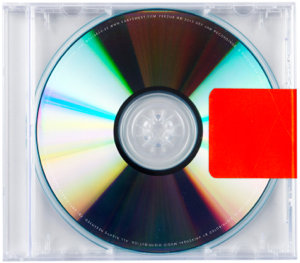
Kanye West’s Album, Yeezus
On June 8th, 2013 hip-hop artist Kanye West released his sixth album, Yeezus. Critically acclaimed, and while it is said to have received mixed reactions from the public, it was certified gold by the RIAA in less than two months. Its sound has almost unanimously been described as aggressive, and is said to have been inspired by varying musical genres from Industrial and Acid House to Chicago Drill. It was recorded in five different cities and three different countries including France, the US, and England, produced in collaboration with an assortment of artists of diverse musical backgrounds, and composed of an eclectic borage of samples from 1970’s Hungarian metal group, Omega, to the choral arrangement, “Sermon (He’ll Give Us What We Really Need),” sung by the Holy Name of Mary Choral Family.
It is an album that is interlaced with themes that seem inevitably tied to race, and both inter and intra race relations. His message is expressed through his own voice, and seemingly at times through his godly alter ego, “Yeezus.” By way of lyrical references and musical samples the album’s discussion of the contemporary situation of black Americans is grounded historically in the famous Jazz song “Strange Fruit,” first recorded in 1939 with vocals by Billie Holiday. It was not only that Holiday’s voice was the first associated with the melody, but also that the song’s tragic message seems so well suited to her style, that it, although covered by many others, is undoubtedly thought of in relation to her till this day. She, like her contemporaries and the female Blues and Jazz singers that preceded her, was, because of her race and gender, regarded in the dimmest light in a white-male dominated society. Having even less political liberty than her black-male contemporaries, her voice—its wavering hum and delicate touch, finding refuge in the offbeat—has an effect not unlike the harmonica. Her delivery fills us with the joy of suffering and, like the desert, reminds us of the loneliness of liberation.
The lyrics of “Strange Fruit” were originally composed as a poem written by Abel Meeropol, about the lynching of blacks in the American South. In it we find only suffering. But, Holiday’s voice sways and creaks like the mournful tree she sings of, and at times sinks rapidly as if oppressed by southern humidity. The song’s message enters the world through an upsurge from deep within her—it is liberated, and it fills us accordingly.
On the fourth track on Yeezus, “New Slaves,” West references “Strange Fruit” with the line, “I know that we the new slaves, I see the blood on the leaves,” and most directly on the seventh track, “Blood On the Leaves,” where a cover of the song by Nina Simone is sampled throughout. Apart from her voice, which has a deeper, more forceful thrust than Holiday’s and may have seemed a more melodious fit with the dark rhythms of the album and song, it is perhaps Simone’s persona that likewise sounds more in harmony with Yeezus. She emerged as a performer in the mid-50’s and her popularity continued to grow throughout the 60’s and 70’s during a time of great social unrest when both women and African Americans were protesting for equal rights. Simone was an icon of both African American and feminine strength. Her songs, such as “Mississippi Goddam,” and her performances were charged with profound passion and, on occasion, aggression. Ironically it is her rendition of “Strange Fruit” that begins the seventh track immediately following the most misogynistic song on the album, “I’m In It.”
Soon after “Blood On the Leaves” begins the voice of West slides into the song between the folds of rhythm and history. His voice is auto-tuned—which at this point is less of a sound effect than a musical phenomenon suggestive of our dependence on soft technologies and a progressive computerization of human beings. He sings about an unrequited love affair, the first party the couple went to together, which was likewise the first time they took Molly (MDMA). He announces that they “could have been some body” and reminisces about the time the molly “came out of” his partner’s body and likewise when “it came out of their body.” Meanwhile Simone’s voice is interspersed throughout, singing the refrain “black bodies swinging in the southern breeze.” This famous and horrific line, which originally addressed the lifeless swing of lynched black Americans hanging from trees during the first half of the 1900’s is satirically re-contextualized to sound like this swing refers to the bodily movements of a black couple commenced in a drug-induced dance sometime in the 21st century.
It is not insignificant that the drug of choice is Molly, which might be, at least in the metropolises of America and Europe, the chosen drug of our time. It is referenced often in popular music, including songs by Jay-Z, Rick Ross, and Miley Cyrus. Taken at parties as West tells us and taken at clubs, but undoubtedly taken somewhere with music. While people most likely remain dancing for the duration of the drug in a single enclosed venue (perhaps a club or a barricaded field), they are moved by a sensation of ultimate liberation. It is not without reason that West sings “it came out of their body [singular]” because at these parties it is as if everyone “rolls” together. While there are some with talent and others with none, and though their dancing styles vary, they all are moved by the same electronic sounds emanating from gigantic speakers. They unabashedly invade each other’s personal-spaces, and, as if the music “comes out of their body,” they move together like a single throbbing organ. It is a profound blur of individual psyches—a mass grouping of human lives becoming electronic, blended and rolling together.
Although West’s song, “Blood on the Leaves,” is most likely an intentional re-contextualization and radical alteration in meaning of Holiday’s original work, it is also attributable to forty years of sampling and an ever-expansive database from which to retrieve these sound bytes. Not unlike the molly-induced dance floor, boundaries break down between the songs’ individual parts and the significance of the historically and culturally relevant juxtapositions get compressed and lost. They no longer communicate. They revert to single circuit information.
Yeezus, like a lot of music right now, is influenced by many genres—it would seem difficult, if not even at times negligent, to deny an entire world that sits at our fingertips. In the case of Yeezus these differing sounds often harmonize and flow, but at others they battle for space. The second track and first single off the album, “Black Skinhead,” for instance, has a beat which is militaristic and almost undeniably reminiscent of the 1996 single, “The Beautiful People,” by the popular industrial metal band, Marilyn Manson. On most tracks though, the rhythm is much less like that of a machine-gun.
While the beat of most songs has a sound of digital industry, the melodic voice-over—whether it be West’s or another’s—seems at times to drag on, as if it were slowed down. It is reminiscent of the “chopped and screwed” hip-hop remixes begun in Houston in the early 90’s, in which previously recorded tracks are slowed to the point where the song becomes almost unidentifiable from its source. The effect this has on sound is perhaps best visualized in “Swangin’ and Bangin,’” both a song by the Houston based rapper ESG, and a style of driving performed by the genre’s listeners. Cars are driven slowly down the road while swerving side to side as if to make contact with as much of the street as is physically possible. As with “Swangin’ and Bangin,” screwed rap seems intent on both slowing time and, more importantly, filling space. On Yeezus, this sound is coupled by abrupt stoppages in the beat and sudden inclusions of new elements. It is as if these cars intent on “Swangin’ and Bangin’” began to stutter in the street, jumping forward or backward at unexpected intervals, before they or the street itself disappears entirely from the scene.
This is not the first or the only album on which this glitch seems to occur. Another example, though not the only one, can be heard in the music of the English producer Evian Christ, who worked with West on the sixth track of Yeezus, “I’m In It.” Evian Christ’s sound is likewise influenced by a borage of genres and, quite often, the music stutters. Sometimes a new element enters that seems out of place or strange noises scatter like marbles across the top of the track. The seamless flow of rhythms and intermix of divergent genres is perhaps becoming generic—the artifice is being exposed. It is perhaps visualized best in one of the most recent styles of Dubstep dancing called “glitch.” While it recalls the dance movements of the “pop-and lockers” of the past, “glitch” has eliminated much of the fluidity that typified its predecessor. Watching a “glitch” performance is like watching someone dance on Skype or Facetime; complete with dropouts and stutters, it would seem that the dance’s function is to malfunction.
For most, all of Yeezus might at first come as a shock, but in regards to the glitch, there are two moments on the album that seem most striking. On the first track, “On Sight,” and the Fourth, “New Slaves,” the most apparent examples occur. The beat for “On Sight” is fast, aggressive and industrial, reminiscent of certain types of EDM (Electronic Dance Music). Its flow is consistent, but at around one minute and fifteen seconds into the song something happens. Everything stops abruptly. As if someone by mistake had twisted a knob on an old transistor radio, we hear something entirely new: The Holy Name of Mary Choral Family singing “Sermon (He’ll Give Us What We Really Need).” Although it was recorded at the time of the album’s production, the sound is muffled and grainy as if recorded over 50 years ago. Like the initial sensation of falling that overcomes us when getting on an out-of-service escalator and are forced to take our first awkward step to make the stairs connect, this sudden and arrhythmic transition in song forces us to connect the divided parts. While we must forget the beat of the previous section in order to make sense of the rhythm in the next, we are compelled to assess the words of the following section in relation to the former if we are to find a correlation. Through us these fragments communicate.
On the fourth track, “New Slaves,” something like this glitch occurs again. Whether it be a satirical and insincere assertion, West professes his understanding that “we”—he and all black Americans—are “the new slaves” because of an obsession with material items, derived from a social condition imposed on them by corporate white America. African Americans buy into their enslavement West argues, while assumedly (corporate) white America “confuse us [blacks] with some bullshit about a New World Order.” This described condition of enslavement is propagated by deceit—lies about a better, though unlikely, future when social inequalities will be removed, or, at the very least, that these injustices are being considered at present.
While addressing systems of control that cannot be separated from monetary profit, West’s argument is not limited to a dialectic focused solely on the distribution of material goods. He asserts that any discussion of change is “bullshit” because “meanwhile the DEA/ Teamed up with the CCA/ They tryna lock niggas up/ Tryna make new slaves/ See that’s that private owned prison/ Get your piece today.” With these lines West alludes to the fact that it is not coincidental that there are, by far, more black men incarcerated in American prisons (and, not to mention, serving on average significantly longer sentences for the same crimes committed by whites). The Corrections Corporation of America (CCA) is a private, for-profit, organization that controls the lives of tens of thousands of inmates throughout the country. Because an increase in profit is directly attributable to an increase in incarcerations West, who is certainly not foreign to matters of business, suggests that it is all too probable that they worked out a profitable arrangement with the Drug Enforcement Agency (DEA). Whether or not this accusation holds weight is certainly relevant. But, while it could be inaccurate, West’s argument, even if only suggestive of the social injustice that these prison statistics imply, is without a doubt one of great concern.
At around two minutes and forty seconds into the song there is a break. The sound changes, but the beat remains the same. Instead of West’s, we now hear a high-pitched computerized voice singing something which is seemingly indiscernible. Then, as if because of some defect, the beat stops abruptly, an escalating drum roll enters and we are carried into a section of the song that is perfectly unlike everything that came before. While what we hear are the singing voices of West and Frank Ocean recorded at the time of production, the sound is muffled (like the section of “On Sight”), like a recording from long ago discovered somewhere collecting dust. Their voices are heard over music suggestive of stringed instruments that have lost their autonomy because of poor recording techniques or the compression of time. As before, this transition is abrupt, reminiscent of the surprise of radio now dwindling from most of our lives.
It is a nostalgic sound, perhaps even one of mourning. Like some sort of interference in audio waves, we are hearing a radio broadcast from the past—one smack to the side of our computer or iPod and we might hear the quivering voice of Billie Holiday on the next station. As with West’s previous reference to “Strange Fruit” earlier in the song—“I see the blood on the leaves”—this alteration in sound likewise acts as a metaphor for all that has, or has not, transpired since Holiday’s original recording. It is a past coming to terms with the present (and vice versa). This glitch compels us to reflect upon the artifice. It is like a good-natured American who refuses to smile and thereby exposes the disconnect between the gesture and the significance of its message. It reminds us of a muted suffering and the many voices that go unheard. There is nothing left, but to smack the side of our own illusion.
Historian and black civil rights activist W.E. B. Du Bois famously stated that “the problem of the Twentieth Century is the problem of the color line”. This prediction, though correct, is sadly limiting for the problem has continued into the 21st. As before, it still remains that one’s perception of this line is directly related to the side on which they find themselves. The lasting effect of such landmark moments as Brown v. Board of Education in 1954, or, Martin Luther King Jr.’s I Have a Dream speech in 1963 is twofold. These moments are significant in part because they held the nation accountable for its blatant injustices and inspired a social awareness that can be felt to this day. They likewise inspired many Americans to question for the first time the relevance of race and the cultural and historical make-up of one’s personal identity.
But today, to be racially privileged is not only to be the possessor of greater freedom and the one with a better opportunity for monetary success. It is to be born on a side afforded the privilege to disacknowledge that there is a side at all. In a self-reflexive culture; an American culture; a culture of infinite databases, samples, and the Internet; where our understanding of culture seems to be typified by a process of retrieval, in which we reconfigure older concepts, juxtapose social statistics, historical narratives and cross-cultural beliefs in the hopes of ascertaining a new vision of who we are now by way of a reconstructed vision of the past, these prolific moments that mark the beginnings of movements are all too easily condensed into marks alone, and are referred to by those who are privileged as the time when racism was expunged—when the sides flowed together and the line was blurred.
Crimes of racism are rationalized by their perpetrators through the denial that their beliefs are racist. In a culture of political correctness, the outright-racist knows of racism’s contemporary relationship to incorrectness, and thus refrains from calling his actions racist in order to maintain a semantically logical correctness. It is likewise America’s reliance on this political correctness that puts a smiling face on continued injustice because racism, as always, works by denying the presence of race. To be privileged is to entertain illusions of color blindness. It is to neglect that in schools and elsewhere, people of differing races are to this day, not only quite often separate, but always unequal. The existence of these illusions is ultimately what made the Trayvon Martin case so much more tragic. President Barack Obama’s reminder that we do not live in a post-racial society was sadly intended for, and shocked, only one group of people.
It is probably only when we consider the glitch in relation to Kanye West’s new album that it has such racially significant depth. It is certainly only when we consider our conception of the Internet’s space and the way in which we move through it, or it through us, that it relates at all to the American Landscape. Its content and formation is international, but its seeming borderless flow is on par with the land of artifice.
Musically, the intentional incorporation of such a glitch suggests that this flow might have become too smooth and the artifice too thick to have left very much in terms of content in its wake—it has become too repetitious and all too superficial. On albums like Yeezus, the structure is being exposed and between the gaps we are left to wonder where exactly it is we are going. As with the Internet, the musical glitch is suggestive of a breakdown in communication. It reminds us of a voice—perhaps our own—that has been lost. But, as it becomes popularized and then normalized, these previously unheard voices resounding from deep within the glitch might once again be muted. In this case, it will not be by force, but because we chose no longer to hear them. If this occurs the act of listening to our contemporary score will be hardly an act of listening at all.
Sam Swasey is an associate editor of The Forgetory.
